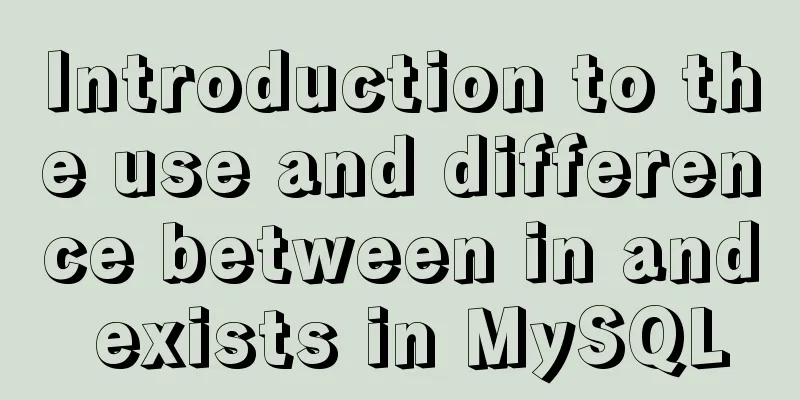MySQL 8.0 can now handle JSON

|
Preface: After a long test, the whole system will be migrated to https://dev.mysql.com/doc/ref... 1. Brief Overview 2. JSON basic tools
//Use the JSON_ARRAY method to define a JSON array;
SELECT JSON_ARRAY(1, "abc", NULL, TRUE, CURTIME())
//Result: [1, "abc", null, true, "11:30:24.000000"]
//JSON_OBJECT method defines JSON object SELECT JSON_OBJECT('id', 87, 'name', 'carrot')
//Result {"id": 87, "name": "carrot"}
//Array and object nesting scenarios;
[99, {"id": "HK500", "cost": 75.99}, ["hot", "cold"]] {"k1": "value", "k2": [10, 20]}
//Date/time type definition ["12:18:29.000000", "2015-07-29", "2015-07-29 12:18:29.000000"]
//JSON_QUOTE escapes the JSON object into a String, that is, escapes the internal symbols and wraps the whole object in double quotes;
JSON_QUOTE(' "null" ')
//Result "\"null\""
//Beautify and output the JSON content;
JSON_PRETTY()
//You can convert JSON/elements inside JSON into other data types;
//Convert the id element in JSON jdoc to unsigned int as follows;
[https://dev.mysql.com/doc/refman/8.0/en/json.html#json-converting-between-types] (https://dev.mysql.com/doc/refman/8.0/en/json.html#json-converting-between-types)
ORDER BY CAST(JSON_EXTRACT(jdoc, '$.id') AS UNSIGNED);
The -> --> operator, finds the value according to the key; the difference is that --> will remove the " and escape characters; its equivalent
// {"mascot": "Our mascot is a dolphin named \"Sakila\"."}
mysql> SELECT col->"$.mascot" FROM qtest;
// Result: | "Our mascot is a dolphin named \"Sakila\"." |
SELECT sentence->>"$.mascot" FROM facts;
// Result: | Our mascot is a dolphin named "Sakila". |
3. JSON Path expression The content between the double quotes above --> is the so-called Take the following JSON as an example:
[3, {"a": [5, 6], "b": 10}, [99, 100]]
$[0] = 3 ;
$[1] = {"a": [5, 6], "b": 10};
$[2] = [99, 100];
At the same time, $[1], $[2] are not scalars, further $[1].a = [5,6] $[1].a[1] = 6 $[1].b = 10; $[2][0] = 99; Further supported syntax features $[n to m]
$[ 1 to 2] = [{"a": [5, 6], "b": 10}, [99, 100]]
$[last-2 to last-1] = [3, {"a": [5, 6], "b": 10}]
To summarize;
4. Find and modify JSON
//As above, it should be possible to use --> syntax instead;
mysql> SELECT JSON_EXTRACT('{"a": 1, "b": 2, "c": [3, 4, 5]}', '$.*');
//[1, 2, [3, 4, 5]]
SELECT JSON_EXTRACT('{"a": 1, "b": 2, "c": [3, 4, 5]}', '$.c[*]')
//[3, 4, 5]
SELECT JSON_EXTRACT('{"a": {"b": 1}, "c": {"b": 2}}', '$**.b');
//[1, 2]
SELECT JSON_EXTRACT('[1, 2, 3, 4, 5]', '$[1 to 3]');
//[2, 3, 4]
//JSON_SET JSON_INSERT JSON_REPLACE JSON_REMOVE
SET @j = '["a", {"b": [true, false]}, [10, 20]]';
SELECT JSON_SET(@j, '$[1].b[0]', 1, '$[2][2]', 2);
//| ["a", {"b": [1, false]}, [10, 20, 2]]
SELECT JSON_INSERT(@j, '$[1].b[0]', 1, '$[2][2]', 2);
//["a", {"b": [true, false]}, [10, 20, 2]]
JSON_REPLACE(@j, '$[1].b[0]', 1, '$[2][2]', 2)
//["a", {"b": [1, false]}, [10, 20]]
SELECT JSON_REMOVE(@j, '$[2]', '$[1].b[1]', '$[1].b[1]');
//["a", {"b": [true]}]
A common scenario
SELECT * FROM JSON_TABLE( '[{"a":"3"},{"a":2},{"b":1},{"a":0},{"a":[1,2]}]',
-> "$[*]"
-> COLUMNS(
-> rowid FOR ORDINALITY,
-> ac VARCHAR(100) PATH "$.a" DEFAULT '111' ON EMPTY DEFAULT '999' ON ERROR,
-> aj JSON PATH "$.a" DEFAULT '{"x": 333}' ON EMPTY,
-> bx INT EXISTS PATH "$.b"
-> )
-> ) AS tt;
I don’t feel it’s worth it at the moment; I don't think it's worth it at the moment; you can use the aggregate function by converting the return value to another type; This is the end of this article about MySQL 8.0 can operate JSON. For more relevant MySQL 8.0 operation JSON content, please search 123WORDPRESS.COM's previous articles or continue to browse the following related articles. I hope everyone will support 123WORDPRESS.COM in the future! You may also be interested in:
|
<<: How to set horizontal navigation structure in Html
>>: ElementUI component el-dropdown (pitfall)
Recommend
Detailed explanation of CocosCreator message distribution mechanism
Overview This article begins to introduce content...
Uninstalling MySQL database under Linux
How to uninstall MySQL database under Linux? The ...
Vue large screen data display example
In order to efficiently meet requirements and avo...
HTML embedded in WMP compatible with Chrome and IE detailed introduction
In fact, there are many corresponding writing met...
Detailed installation and use of virtuoso database under Linux system
I've been researching some things about linke...
Detailed explanation of a method to rename procedure in MYSQL
Recently I have used the function of renaming sto...
Full analysis of MySQL INT type
Preface: Integer is one of the most commonly used...
Examples of importing and exporting MySQL table data
This article describes the import and export oper...
Simple usage example of vue recursive component
Preface I believe many students are already famil...
Background image cache under IE6
CSS background image flickering bug in IE6 (backg...
MySQL database deletes duplicate data and only retains one method instance
1. Problem introduction Assume a scenario where a...
A brief discussion on the synchronization solution between MySQL and redis cache
Table of contents 1. Solution 1 (UDF) Demo Case 2...
How to run .sh files in Linux system
There are two ways to run .sh files in Linux syst...
Teach you the detailed process of installing DOClever with Docker Compose
Table of contents 1. What is Docker Compose and h...
A brief analysis of the examples and differences of using nohup and screen to run background tasks in Linux
Using SSH terminal (such as putty, xshell) to con...









